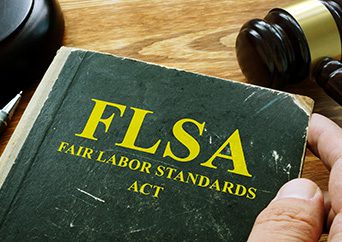Important Dates
- July 1, 2024: The standard salary level for white-collar employees will increase to $844 per week for EAP employees and $132,964 per year for HCEs.
- January 1, 2025: The standard salary level for white-collar employees will increase to $1,128 per week for EAP employees and $151,164 per year for HCEs.
Highlights
- The salary level for the EAP exemptions will increase to $844 per week ($43,888 per year) on July 1, 2024, and then to $1,128 ($58,656 per year) on January 1, 2025.
- The salary level for HCEs will increase to $132,964 annually on July 1, 2024, and then to $151,164 annually on January 1, 2025.
- The final rule does not impact the salary basis or duties tests for the white-collar FLSA exemptions.
- The rule allows the DOL to update salary levels automatically every three years starting on July 1, 2027.
The U.S. Department of Labor (DOL) announced a final rule on April 23, 2024, to amend current requirements employees in white-collar occupations must satisfy to qualify for an overtime exemption under the Fair Labor Standards Act (FLSA). The final rule will take effect on July 1, 2024. The FLSA white-collar exemptions apply to individuals in executive, administrative, professional (EAP) and some outside sales personnel and computer-related occupations. Some highly compensated employees (HCEs) may also qualify for an FLSA white-collar exemption. To qualify for most white-collar exemptions, employees must meet the specified salary threshold, among other criteria.
Starting July 1, 2024, the DOL’s final rule increases the salary level from:
- $684 to $844 per week ($35,568 to $43,888 per year) for EAP employees; and
- $107,432 to $132,964 per year for HCEs.
On January 1, 2025, the salary level will then increase from:
- $844 to $1,128 per week ($43,888 to $58,656 per year) for EAP employees; and
- $132,964 to $151,164 per year for HCEs.
The rule also enables the DOL to update the salary levels automatically every three years starting on July 1, 2027.
Action Steps
According to the DOL, updating the salary level test will help ensure that the FLSA’s intended overtime protections are fully implemented. Employers should become familiar with the final rule and evaluate what actions they may need to take to comply with its requirements. This Compliance Bulletin summarizes the rule changes and describes steps employers may take in response to the final overtime rule.
Background on the Overtime Rule
The FLSA requires employers to pay employees overtime pay at a rate of 1.5 times their regular rate of pay for all hours worked over 40 in a workweek unless the employees qualify for an exemption under the FLSA. The FLSA provides several exemptions from the overtime pay requirements, the most common of which are the “white-collar” exemptions. These exemptions primarily apply to EAP employees but also to some individuals in outside sales and computer-related occupations and certain HCEs.
To qualify for most white-collar exemptions, an employee must satisfy the following tests:
- The salary basis test requires that the employee is paid a predetermined and fixed salary that does not fluctuate based on the quality or quantity of work;
- The salary level test requires that the employee meets a minimum specified amount to qualify for the exemption. The current salary threshold is $684 per week ($35,568 per year). The current compensation threshold for HCEs is $107,432 per year ($35,568 of which must be earned on a salary basis). However, outside sales personnel and certain other professions, including doctors, lawyers and teachers, are not subject to the salary level test; and
- The duties test requires that an employee’s actual work responsibilities match the description the FLSA assigns to the exemption. HCEs are subject to a less restrictive duties test.
The DOL’s final rule amends current requirements employees in white-collar occupations must satisfy to qualify for an FLSA overtime exemption. To qualify for this exemption under the final rule, white-collar employees must satisfy the new standard salary level tests.
Under the final rule, starting July 1, 2024, the DOL will update the standard salary level and HCE’s total annual compensation requirements using existing methodology from the 2019 final rule (i.e., setting the standard salary level at the 20th percentile of weekly earnings of full-time salaried workers in the lowest-wage Census Region and the HCE total annual compensation threshold at the annualized weekly earnings of the 80th percentile of full-time salaried workers nationally) and current data as follows:
- The salary level for EAP employees will increase from $684 per week to $844 per week (equivalent to $43,888 per year); and
- The HCE total annual compensation threshold will increase from $107,432 to $132,964.
Then, on January 1, 2025, the DOL will implement the new salary methodology, setting the standard salary level at the 35th percentile of weekly earnings of full-time salaried workers in the lowest-wage Census Region and the HCE total annual compensation threshold at the annualized weekly earnings of the 85th percentile of full-time salaried workers nationally. This will result in the following changes:
- The salary level for EAP employees will increase from $844 per week to $1,128 per week (equivalent to $58,656 per year); and
- The HCE total annual compensation threshold will increase from $132,964 to $151,164.
The final rule introduces a mechanism to regularly update the standard salary level and HCE total annual compensation thresholds, including an initial update to reflect earnings growth, which will be on July 1, 2024. This update will be followed by triennial updates in the future that will apply updated earnings data to the methodologies in effect at the time of the updates. The next three-year update will take place on July 1, 2027. At least 150 days before the date of a scheduled update to the standard salary level and the HCE total annual compensation requirement, the DOL will publish a notice with the new earnings levels in the Federal Register. However, the DOL may temporarily delay a scheduled update for 120 days where unforeseen economic or other conditions warrant.
Responding to the New Overtime Rule
Identify Affected Employees
Employers should review payroll data to identify which employees will be affected by the new overtime rule. Specifically, the final rule will affect employees classified as exempt and earning an annual salary of less than $43,888, and HCEs classified as exempt and earning annual compensation of less than $132,964 as of July 1, 2024. In determining total compensation for purposes of the HCE exemption, only $43,888 of such compensation must be paid on a salary basis, and the remaining compensation may consist of commissions, nondiscretionary bonuses and other nondiscretionary compensation. Employers’ efforts to prepare for the new overtime rule should also include identifying any employees that will be affected by the further increase to the standard salary level ($58,656) and HCE total annual compensation threshold ($151,164) that will occur on January 1, 2025.
Employees who are already classified as nonexempt from overtime under the FLSA will not be affected by the new overtime rule, regardless of their compensation.
Determine Treatment of Affected Employees
Highly Compensated Employees
To qualify for a white-collar exemption, HCEs are subject to a more relaxed duties test, which requires only that the employee’s primary duty must be office or nonmanual work and the employee must customarily and regularly perform at least one of the bona fide exempt duties of an EAP employee. For HCEs who are currently classified as exempt but earn less than the annual compensation threshold under the final rule ($132,964 as of July 1, 2024, and $151,164 as of January 1, 2025), employers should assess whether they may still qualify for an exemption under the more stringent duties test applied to other white-collar exemptions. If they cannot satisfy that duties test, then employers must decide whether to raise their salaries to meet the new HCE compensation threshold or reclassify them as nonexempt employees once the new rule becomes effective.
All Other Affected Employees
After identifying any affected employees, employers need to take one of the following actions with respect to such employees as of the rule’s effective date:
- Raise their salaries so as to satisfy the salary level test for an exempt classification; or
- Reclassify the employees as nonexempt from overtime.
Employers are not required to take the same approach for all affected employees. However, it is generally considered best practice to assign the same classification to employees with the same job title and duties. Thus, employers may wish to make such determinations on a position-by-position basis rather than individually.
Further, to the extent employers choose to reclassify affected employees as nonexempt, employers will need to decide whether to pay newly nonexempt employees on an hourly rather than salary basis. Nonexempt employees are typically, but not required to be, paid on an hourly basis. Paying nonexempt employees hourly generally simplifies the process of determining overtime pay and ensures employees are paid only for hours worked. However, some employees view salaried positions as more prestigious and appreciate the predictability of a salary that does not fluctuate between paychecks. Therefore, employers may also need to consider the potential impacts on employee morale.
Track and Analyze Hours Worked
Under the FLSA, employers are required to track hours worked by nonexempt employees for purposes of calculating overtime (i.e., payment for hours worked in excess of 40 in a workweek). Employers may better prepare for the new rule by tracking and analyzing the hours worked by affected employees. This can help employers determine the potential cost of reclassification and influence an employer’s decision to either reclassify affected employees as nonexempt or increase their salaries. For example, if affected employees rarely work more than 40 hours per week, reclassifying them as nonexempt may be more cost-effective. Conversely, if the affected employees regularly work more than 40 hours per week, it may be more cost-effective to avoid paying substantial overtime by increasing their salaries to retain their exempt status.
Review and Update Employer Policies
Overtime
Employers that want to limit the amount of overtime worked by reclassified employees should consider a policy of requiring overtime hours to be approved in advance and disciplining employees who violate such policy (employers are still required to pay for all overtime work even if not preapproved). However, employees who regularly work more than 40 hours per week as exempt employees may not be able to accomplish as much work if they are limited to working a maximum of 40 hours per week after reclassification. Therefore, employers that choose to restrict overtime may also consider whether to modify performance expectations, shift duties or responsibilities, or hire additional workers.
Timekeeping
Under the new overtime rule, employers may consider how existing timekeeping practices will apply to any affected employees the employer reclassifies as exempt and whether any modifications are required. For example, if employers reclassify remote or hybrid workers as nonexempt, employers will need to ensure that such workers will be able to record time remotely. Moreover, employers may need to establish additional guardrails for work performed at irregular times or off-site. For example, if affected employees conduct work remotely outside of business hours (e.g., answering emails during evenings or weekends), employers may need to modify their policies to ensure that such time is properly recorded or require all work to be conducted during business hours.
Other Employee Policies
Employers may also consider reviewing existing policies that differentiate between exempt and nonexempt workers and consider potential implications for reclassified employees. For example, employers may offer different vacation policies or bonus opportunities depending on an employee’s exempt status.
Develop Internal Communications
Employers that choose to reclassify affected employees should communicate the change with employees in advance of the date such reclassification takes effect. The communications should generally include an explanation of the change in employee classification, the date such change goes into effect, a description of the organization’s timekeeping policies (and meal and rest break policies, if applicable), the employees’ obligations under such policies, and a description of any changes under employer policies that differentiate between exempt and nonexempt employees (e.g., vacation policies). Some employees could view the reclassification to nonexempt as a demotion, so employers may want to reassure employees that the change has no effect on their status and emphasize the positive aspects of reclassification, such as overtime eligibility.
Employers should notify managers of the new requirements so that they understand their obligations with respect to newly nonexempt employees, such as reviewing and authorizing overtime. Employers may also consider notifying payroll personnel of any potential changes to employee paychecks, such as paying and calculating overtime and converting salaried employees to hourly employees. As the DOL’s final rule has been published, employers may consider preparing and issuing these communications now. However, the final rule is expected to face legal challenges similar to those of the 2016 overtime rule, which resulted in substantial delays and was ultimately blocked and abandoned by a new administration. Therefore, employers should watch for updates as they develop and issue internal communications regarding classification and other changes.
Prepare Employee and Manager Trainings
Employees who are reclassified may be unfamiliar with timekeeping and other practices applicable to only nonexempt employees. Therefore, in addition to communicating the change, employers may consider training reclassified employees on timekeeping, hours scheduling, overtime approval, meal and rest breaks, and any other policies applicable only to nonexempt employees prior to the effective date of their reclassification. Managers of the reclassified employees may need additional training to understand their obligations with respect to such employees, such as approving or denying overtime and ensuring hours are accurately tracked and reported. While employers can begin preparing training programs and conducting training now, they should watch for updates and monitor potential challenges.
Audit Exempt Employees’ Job Duties
Although the final overtime rule does not make any changes to the duties requirements for exempt classification, employers may also consider a broader audit on whether their exempt employees’ job duties and responsibilities satisfy the FLSA’s duties tests for white-collar exemptions. Employers may wish to review existing job descriptions for exempt positions to ensure they accurately reflect the work performed.
Review Applicable State and Local Overtime Laws
Some employers may already be subject to state or local laws that impose a higher salary threshold to qualify for an overtime exemption. Therefore, employers should continue to evaluate proper employee classifications using applicable state and local criteria as well as federal criteria.
Additionally, certain state and local laws, including those regarding meal and rest breaks, may only apply to nonexempt employees. Employers that reclassify employees as nonexempt should determine whether any such state or local wage and hour laws may apply to the reclassified employees and, if so, should inform the employees of these additional rights and benefits.
Monitor for Updates and Legal Challenges
While employers may take steps now to prepare for the final rule, they may want to wait to implement any concrete changes before it takes effect. As noted, the final rule is expected to face legal challenges. Accordingly, employers should watch for updates and prepare for potential uncertainty following the final rule’s publication.
Provided to you by The Horton Group, Inc.
Material posted on this website is for informational purposes only and does not constitute a legal opinion or medical advice. Contact your legal representative or medical professional for information specific to your legal or medical needs.




